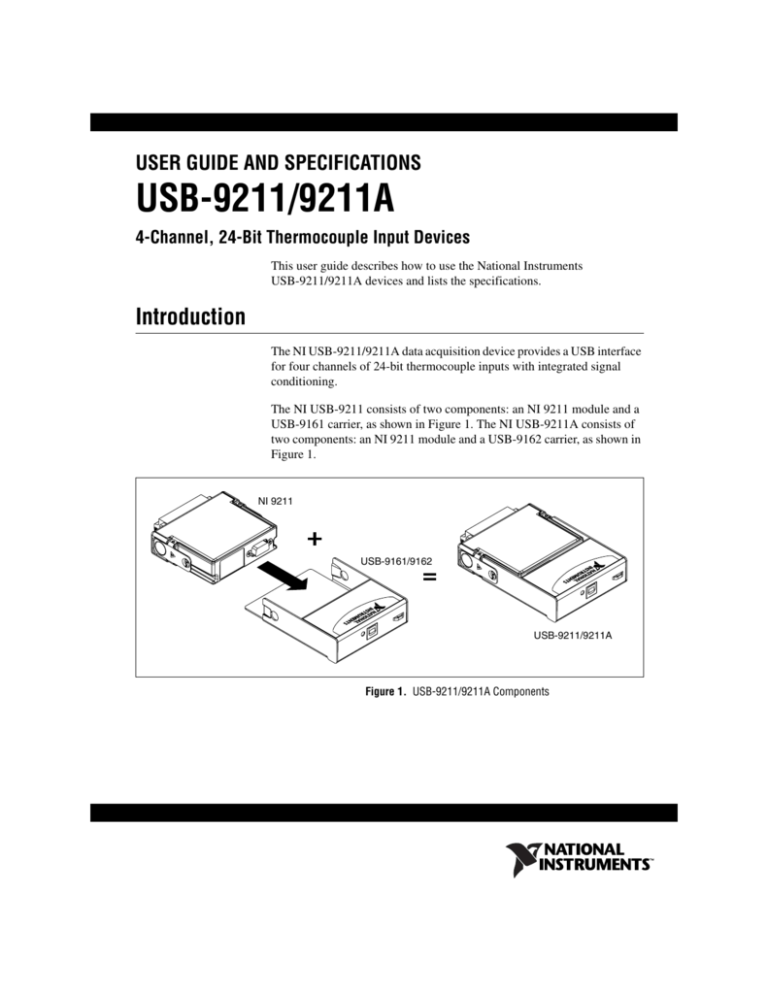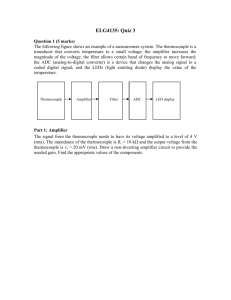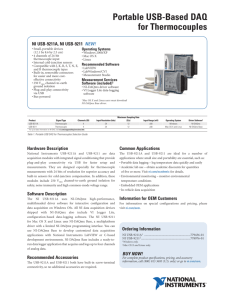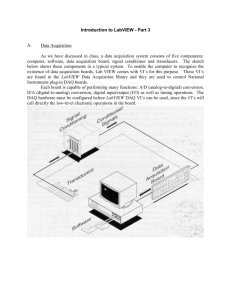
USER GUIDE AND SPECIFICATIONS
USB-9211/9211A
4-Channel, 24-Bit Thermocouple Input Devices
This user guide describes how to use the National Instruments
USB-9211/9211A devices and lists the specifications.
Introduction
The NI USB-9211/9211A data acquisition device provides a USB interface
for four channels of 24-bit thermocouple inputs with integrated signal
conditioning.
The NI USB-9211 consists of two components: an NI 9211 module and a
USB-9161 carrier, as shown in Figure 1. The NI USB-9211A consists of
two components: an NI 9211 module and a USB-9162 carrier, as shown in
Figure 1.
NI 9211
USB-9161/9162
USB-9211/9211A
Figure 1. USB-9211/9211A Components
Dimensions
Figure 2 shows the USB-9211/9211A device dimensions.
Hi-Speed USB Carrier
NI USB-9162
4.751
4.656
5.521
5.426 (120.68) (118.26)
(140.23) (137.82)
3.469
(88.12)
0.998
(25.34)
Figure 2. USB-9211/9211A Series Devices in Inches (Millimeters)
Safety Guidelines
Operate the USB-9211/9211A only as described in these operating
instructions.
Although the NI 9211 module may have more stringent certification standards than
the USB-9211/9211A, when used with the USB-9161/9162 carrier, the combined system
may be limited. Refer to the Specifications section for more details.
Note
Hot Surface This icon denotes that the component may be hot. Touching this component
may result in bodily injury.
Do not disconnect I/O-side wires or connectors unless power has been switched
off or the area is known to be nonhazardous.
Caution
Caution Do not remove modules unless power has been switched off or the area is known
to be nonhazardous.
Caution
The USB-9211/9211A is not certified for use in hazardous locations.
USB-9211/9211A User Guide and Specifications
2
ni.com
Safety Guidelines for Hazardous Voltages
If hazardous voltages are connected to the module, take the following
precautions. A hazardous voltage is a voltage greater than 42.4 Vpk or
60 VDC to earth ground.
Ensure that hazardous voltage wiring is performed only by qualified personnel
adhering to local electrical standards.
Caution
Caution
Do not mix hazardous voltage circuits and human-accessible circuits on the same
module.
Make sure that devices and circuits connected to the module are properly
insulated from human contact.
Caution
Caution When module terminals are live with hazardous voltages, make sure that the
terminals are not accessible by using the high voltage screw terminal enclosure. Refer to
the Assembling the High Voltage Screw Terminal Backshell section for more information.
Software
Software support for your hardware depends on the carrier being used.
Refer to Table 1 for a list of software support.
Table 1. Devices and Corresponding Components
Device
Carrier
Software Support
USB-9211
NI 9161
NI-DAQmx Base
USB-9211A
NI 9162
NI-DAQmx
Examples are included with each software API. Refer to the corresponding
software Getting Started Guide for more information.
© National Instruments Corporation
3
USB-9211/9211A User Guide and Specifications
Related Documentation
Guide
Location
NI-DAQmx Getting Started Guide
Accessible from Start»All Programs»
National Instruments»NI-DAQ after install.
NI-DAQmx for USB Devices Getting Started
Guide
Ships with your device and, after install,
is accessible from Start»All Programs»
National Instruments»NI-DAQ.
NI-DAQmx Base Getting Started Guide
Accessible from Start»All Programs»
National Instruments»NI-DAQmx
Bases»Documentation after install.
If your device uses NI-DAQmx Base, refer to ni.com to download the
software.
Installing the USB-9211/9211A Device
Installing the Software
Before installing the device, you must install the software you plan to use
with the device. Refer to the Software section of this manual and the
documentation included with the software for more information.
Installing the NI USB-9211/9211A in the USB-9161/9162 Carrier
The NI 9211 module and the USB-9161/9162 carrier are packaged
separately. Refer to Figure 3, while completing the following assembly
steps:
1.
Make sure that no signals are connected to the NI 9211 module and the
USB cable is not connected to the device.
2.
Remove the protective cover from the 15-pin DSUB connector.
USB-9211/9211A User Guide and Specifications
4
ni.com
3.
Align the I/O module with the carrier, as shown in Figure 3.
1
1
High Voltage Screw Terminal Backshell
Figure 3. Module Installation
4.
Squeeze the latches and insert the NI 9211 module into the carrier.
5.
Press firmly on the connector side of the NI 9211 module until the
latches lock the module into place, as shown in Figure 4.
Figure 4. Locking Module into Place
6.
© National Instruments Corporation
Connect the USB cable to the assembled USB-9211/9211A.
5
USB-9211/9211A User Guide and Specifications
Mounting the USB-9211/9211A to a Panel
Threaded inserts are located in the USB-9211/9211A for mounting it to a
panel. Refer to Figure 5 for dimensions.
85.7 mm
(3.37 in.)
72.2 mm
(2.84 in.)
Threaded Insert
M3 x 0.5
8.5 mm (0.34 in.) Max Depth
76.1 mm
(3.00 in.)
Figure 5. Module Dimensions
Connecting the USB-9211/9211A to a Computer
Plug one end of the USB cable into the USB-9211/9211A and the other end
into an available USB port on the computer.
LED Indicator
The LED indicator indicates device status.
Table 2. LED State/Device Status
LED State
Device Status
Not lit
Device not connected or in suspend.
On, not blinking
Device connected, but no module installed.
Single-blink
Operating normally.
Double-blink
Operating normally.
Quadruple-blink
Device error. Refer to ni.com/support.
USB-9211/9211A User Guide and Specifications
6
ni.com
Wiring the USB-9211/9211A
The USB-9211/9211A has a 10-terminal, detachable high voltage screw
terminal enclosure that provides connections for four thermocouple input
channels. Each channel has a terminal to which you can connect the
positive lead of the thermocouple, TC+, and a terminal to which
you can connect the negative lead of the thermocouple, TC–. The
USB-9211/9211A also has a common terminal, COM, that is internally
connected to the isolated ground reference of the module.
The high voltage screw terminal backshell must be installed when using
hazardous voltages (>42.4 Vpk, 60 VDC).
Caution
If you are unsure which of the thermocouple leads is positive and which is
negative, check the thermocouple documentation or the thermocouple wire
spool. If you are using shielded wiring, connect one end of the shield to the
COM terminal.
Shield
TC+
Thermocouple
USB-9211/9211A
TC–
COM
Figure 6. Connecting a Thermocouple Input Signal to the USB-9211/9211A
© National Instruments Corporation
7
USB-9211/9211A User Guide and Specifications
Refer to Table 3 for the terminal assignments for each channel.
Table 3. Terminal Assignments
Module
Terminal
Signal
0
TC0+
1
TC0–
2
TC1+
3
TC1–
4
TC2+
4
5
5
TC2–
6
6
TC3+
7
TC3–
8
No connection
9
Common (COM)
0
1
2
3
7
8
9
Assembling the High Voltage Screw Terminal Backshell
The high voltage screw terminal backshell must be installed when using
hazardous voltages (>42.4 Vpk, 60 VDC). Refer to Figure 7 while
completing the following steps:
1.
Connect the leads to the screw terminal and secure with the strain
relief.
2.
Finish by snapping the backshell around the connector.
USB-9211/9211A User Guide and Specifications
8
ni.com
1
1
Strain Relief
Figure 7. High Voltage Screw Terminal Backshell
USB-9211/9211A Circuitry
The USB-9211/9211A channels share a common ground that is isolated
from the chassis and the host computer. Each channel has an impedance
between the TC+ and COM terminals and between the TC– and COM
terminals. Each channel is filtered and then sampled by a 24-bit
analog-to-digital converter (ADC). There is a current source between the
TC+ and TC– terminals. If an open thermocouple is connected to the
channel, the current source forces a full-scale voltage across the terminals.
Effects of Source Impedance on Voltage Measurement Accuracy
The resistors shown in Figure 8 produce an input impedance at the
terminals of the USB-9211/9211A.
© National Instruments Corporation
9
USB-9211/9211A User Guide and Specifications
TC+
10 MΩ
10 MΩ
TC–
COM
Input
Impedance
Open
Thermocouple
Detection
Current
Filtered
Differential
Amplifier
Isolated
ADC
USB-9211/9211A
Figure 8. Input Circuitry for One Channel
If thermocouples are connected to the USB-9211/9211A, the gain and
offset errors resulting from the source impedance of the thermocouples are
negligible for most applications. Other voltage sources with a higher source
impedance can introduce more significant errors. For more information
about errors resulting from source impedance, refer to the Specifications
section.
Determining Temperature Measurement Accuracy and
Minimizing Errors
Temperature measurement errors depend in part on the thermocouple type,
the temperature being measured, the accuracy of the thermocouple, and the
cold-junction temperature.
Using the Autozero Channel
The USB-9211/9211A has an internal autozero channel for measuring the
offset error. If the ambient temperature of the USB-9211/9211A is less than
15 °C or more than 35 °C, use this channel to read the offset error. The
USB-9211 always has this channel enabled. Use NI-DAQmx to configure
the behavior of the autozero channel for the USB-9211A. Refer to the
NI-DAQmx Help, accessible from Start»All Programs»National
Instruments»NI-DAQ, for more information.
USB-9211/9211A User Guide and Specifications
10
ni.com
Measurement Accuracy for the Different Types
of Thermocouples
Figures 9, 10, 11, 12, and 13 show the typical and maximum errors for the
different thermocouple types when used with the USB-9211/9211A over
the full temperature range. The figures also show the maximum error for
the thermocouple types with the USB-9211/9211A at room temperature,
15 to 35 °C. The figures account for gain errors, offset errors, differential
and integral nonlinearity, quantization errors, noise errors, and isothermal
errors. The figures do not account for the accuracy of the thermocouple
itself.
Temperature gradients across the USB-9211/9211A terminals affect the
cold-junction temperature accuracy. Refer to the Cold-Junction
Temperature Measurement Accuracy section for more information about
temperature gradients.
6
Max over Temp Range with Autozero
Max at Room Temp Range without Autozero
Typ over Temp Range with Autozero
Error (°C)
4
2
0
200
400
600
800
1000
1200
1400
Measured Temperature (°C)
1600
1800
Figure 9. Type B Errors
© National Instruments Corporation
11
USB-9211/9211A User Guide and Specifications
4
Max over Temp Range with Autozero
Max at Room Temp Range without Autozero
Typ over Temp Range with Autozero
Error (°C)
3
2
1
0
–200
0
200
400
600
Measured Temperature (°C)
800
1000
Figure 10. Type E and T Errors
4
Error (°C)
3
2
1
0
Max over Temp Range with Autozero
Max at Room Temp Range without Autozero
Typ over Temp Range with Autozero
–200
0
200
400
600
800
Measured Temperature (°C)
1000
1200
Figure 11. Type J and N Errors
USB-9211/9211A User Guide and Specifications
12
ni.com
4
Error (°C)
3
2
1
Max over Temp Range with Autozero
Max at Room Temp Range without Autozero
Typ over Temp Range with Autozero
0
–200
0
200
400
600
800
Measured Temperature (°C)
1000
1200
Figure 12. Type K Errors
Error (°C)
6
4
2
Max over Temp Range with Autozero
Max at Room Temp Range without Autozero
Typ over Temp Range with Autozero
0
–200
0
200
400
600
800 1000 1200
Measured Temperature (°C)
1400
1600
Figure 13. Type R and S Errors
Cold-Junction Temperature Measurement Accuracy
Heat from other nearby heat sources can cause errors in thermocouple
measurements by heating up the terminals so that they are at a different
temperature than the cold-junction compensation sensor used to measure
the cold junction. The thermal gradient generated across the terminals can
cause the terminals of different channels to be at different temperatures, so
the resulting measurement creates errors not only in absolute accuracy but
also in the relative accuracy between channels.
© National Instruments Corporation
13
USB-9211/9211A User Guide and Specifications
Minimizing Thermal Gradients
Thermocouple wire can be a significant source of thermal gradients if it
conducts heat or cold directly to terminal junctions. To minimize these
errors, follow these guidelines:
•
Use small-gauge thermocouple wire. Smaller wire transfers less heat
to or from the measuring junction.
•
Run thermocouple wiring together near the screw-terminal connector
to keep the wires at the same temperature.
•
Avoid running thermocouple wires near hot or cold objects.
•
If you connect any extension wires to thermocouple wires, use wires
made of the same conductive material.
Specifications
The following specifications are typical at 25 °C, unless otherwise noted.
All voltages are relative to COM unless otherwise noted.
Input Characteristics
Number of channels................................4 thermocouple channels,
1 internal autozero channel,
1 internal cold-junction
compensation channel
ADC resolution.......................................24 bits
Type of ADC ..........................................Delta-sigma
Input range ..............................................±80 mV, (not software selectable)
Common-mode range
Channel-to-COM.............................±1.5 V
Common-to-earth ground ................±250 V
Common-mode rejection ratio (0 to 60 Hz)
Channel-to-common ........................95 dB
Common-to-earth ground ................>170 dB
Temperature measurement ranges ..........Works over temperature
ranges defined by NIST
(J, K, R, S, T, N, E, and
B thermocouple types)
USB-9211/9211A User Guide and Specifications
14
ni.com
Cold-junction compensation sensor accuracy
0 to 60 °C ........................................ 0.6 °C (1.1 °F) typ,
1.3 °C (2.3 °F) max
Conversion time ..................................... 70 ms per channel;
420 ms total for all channels
including the autozero and
cold-junction channels
Max sampling rate (Hz)
Type of Measurement
Number of
Channels in
Scan List
Tempertaure
with CJC and
Autozero
Temperature
with Autozero
RAW
Analog
Input
1
4
6
12
2
3
4
6
3
2.4
3
4
4
2
2.4
3
Note: DAQmx Base always applies autozero.
Input bandwidth (–3 dB) ........................ 15 Hz
Noise rejection ....................................... 85 dB min at 50/60 Hz
Overvoltage protection........................... ±30 V between any input and
common
Differential input impedance ................. 20 MΩ
Input current........................................... 50 nA
Input noise.............................................. 1 µVrms
Gain error ............................................... 0.05% max at 25 °C,
0.06% typ (over temperature)
0.1% max (over temperature)
Offset error (with autozeroing) .............. 15 µV typ, 20 µV max
Gain error from source impedance......... 0.05 ppm per Ω source impedance
due to input impedance
© National Instruments Corporation
15
USB-9211/9211A User Guide and Specifications
Offset error from source impedance .......0.05 µV typ, 0.07 µV max per Ω
source impedance due to input
current
Power Requirements
Current consumption from USB.............500 mA, max
Suspend mode..................................2.5 mA, max
Bus Interface
USB specification
USB-9211 ........................................USB 2.0 full speed
USB-9211A .....................................USB 2.0 high speed
Physical Characteristics
If you need to clean the module, wipe it with a dry towel.
Dimensions ............................................14 cm × 8.6 cm × 2.5 cm
(5.51 in. × 3.37 in. × 0.99 in.)
Weight ....................................................Approx. 350 g (12.3 oz)
Screw-terminal wiring ............................12 to 24 AWG wire with 10 mm
(0.39 in.) of insulation stripped
from the end
Torque for screw terminals.....................0.5 – 0.6 N · m
(4.4 – 5.3 lb · in.)
Safety
Standards
The USB-9211/9211A is designed to meet the requirements of the
following standards of safety for electrical equipment for measurement,
control, and laboratory use:
•
IEC 61010-1, EN 61010-1
•
UL 61010-1
•
CAN/CSA-C22.2 No. 61010-1
Note For UL and other safety certifications, refer to the product label, or visit
ni.com/certification, search by model number or product line, and click the
appropriate link in the Certification column.
USB-9211/9211A User Guide and Specifications
16
ni.com
Voltages
Connect only voltages that are within these limits.
Channel-to-COM ................................... ±30 V max,
Measurement Category I
Measurement Category I is for measurements performed on circuits not
directly connected to the electrical distribution system referred to as
MAINS voltage. MAINS is a hazardous live electrical supply system that
powers equipment. This category is for measurements of voltages from
specially protected secondary circuits. Such voltage measurements include
signal levels, special equipment, limited-energy parts of equipment,
circuits powered by regulated low-voltage sources, and electronics.
Isolation
Channel-to-channel ......................... No isolation between channels
Channel-to-earth ground
Withstand................................. 2,300 Vrms, 5 seconds max
Continuous............................... 250 Vrms,
Measurement Category II
Measurement Category II is for measurements performed on circuits
directly connected to the electrical distribution system. This category refers
to local-level electrical distribution, such as that provided by a standard
wall outlet (for example, 115 V for U.S. or 230 V for Europe).
Hazardous Locations
The USB-9211/9211A is not certified for use in hazardous locations.
Environmental
The USB-9211/9211A device is intended for indoor use only.
Operating temperature
(IEC 60068-2-1 and IEC 60068-2-2) ..... 0 to 60 °C
Storage temperature
(IEC 60068-2-1 and IEC 60068-2-2) ..... –40 to 85 °C
Operating humidity
(IEC 60068-2-56) ................................... 10 to 90% RH, noncondensing
Storage humidity
(IEC 60068-2-56) ................................... 5 to 95% RH, noncondensing
© National Instruments Corporation
17
USB-9211/9211A User Guide and Specifications
Maximum altitude...................................2,000 m (at 25 °C ambient
temperature)
Pollution Degree (IEC 60664) ................2
Electromagnetic Compatibility
Emissions................................................EN 55011 Class A at 10 m
FCC Part 15A above 1 GHz
Immunity ................................................EN 61326-1:1997 + A2:2001,
Table 1
EMC/EMI ...............................................CE, C-Tick, and FCC Part 15
(Class A) Compliant
Note
For EMC compliance, operate this device with shielded cabling.
CE Compliance
This product meets the essential requirements of applicable European
Directives, as amended for CE marking, as follows:
Low-Voltage Directive (safety)..............73/23/EEC
Electromagnetic Compatibility
Directive (EMC) .....................................89/336/EEC
Refer to the Declaration of Conformity (DoC) for this product for any additional
regulatory compliance information. To obtain the DoC for this product, visit
ni.com/certification, search by model number or product line, and click the
appropriate link in the Certification column.
Note
Calibration
You can obtain the calibration certificate for the USB-9211/9211A at
ni.com/calibration.
Calibration interval .................................1 year
USB-9211/9211A User Guide and Specifications
18
ni.com
Where to Go for Support
The National Instruments Web site is your complete resource for technical
support. At ni.com/support you have access to everything from
troubleshooting and application development self-help resources to email
and phone assistance from NI Application Engineers.
National Instruments corporate headquarters is located at
11500 North Mopac Expressway, Austin, Texas, 78759-3504.
National Instruments also has offices located around the world to help
address your support needs. For telephone support in the United States,
create your service request at ni.com/support and follow the calling
instructions or dial 512 795 8248. For telephone support outside the United
States, contact your local branch office:
Australia 1800 300 800, Austria 43 0 662 45 79 90 0,
Belgium 32 0 2 757 00 20, Brazil 55 11 3262 3599,
Canada 800 433 3488, China 86 21 6555 7838,
Czech Republic 420 224 235 774, Denmark 45 45 76 26 00,
Finland 385 0 9 725 725 11, France 33 0 1 48 14 24 24,
Germany 49 0 89 741 31 30, India 91 80 41190000,
Israel 972 0 3 6393737, Italy 39 02 413091, Japan 81 3 5472 2970,
Korea 82 02 3451 3400, Lebanon 961 0 1 33 28 28,
Malaysia 1800 887710, Mexico 01 800 010 0793,
Netherlands 31 0 348 433 466, New Zealand 0800 553 322,
Norway 47 0 66 90 76 60, Poland 48 22 3390150,
Portugal 351 210 311 210, Russia 7 095 783 68 51,
Singapore 1800 226 5886, Slovenia 386 3 425 4200,
South Africa 27 0 11 805 8197, Spain 34 91 640 0085,
Sweden 46 0 8 587 895 00, Switzerland 41 56 200 51 51,
Taiwan 886 02 2377 2222, Thailand 662 278 6777,
United Kingdom 44 0 1635 523545
National Instruments, NI, ni.com, and LabVIEW are trademarks of National Instruments Corporation.
Refer to the Terms of Use section on ni.com/legal for more information about National
Instruments trademarks. Other product and company names mentioned herein are trademarks or trade
names of their respective companies. For patents covering National Instruments products, refer to the
appropriate location: Help»Patents in your software, the patents.txt file on your CD, or
ni.com/patents.
© 2005–2006 National Instruments Corporation. All rights reserved.
371566B-01
Mar06








